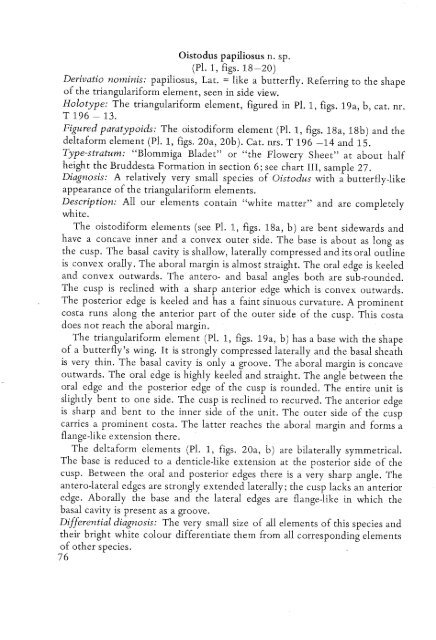UTRECHT MICROPALEONTOLOGICAL BUllETINS
UTRECHT MICROPALEONTOLOGICAL BUllETINS
UTRECHT MICROPALEONTOLOGICAL BUllETINS
Create successful ePaper yourself
Turn your PDF publications into a flip-book with our unique Google optimized e-Paper software.
Oistodus papiliosus n. sp.<br />
(PI. 1, figs. 18-20)<br />
Derivatio nominis: papiliosus, Lat. = like a butterfly. Referring to the shape<br />
of the triangulariform element, seen in side view.<br />
Holotype: The triangulariform element, figured in PI. 1, figs. 19a, b, cat. nr.<br />
T 196 -13.<br />
Figured paratypoids: The oistodiform element (PI. 1, figs. 18a, 18b) and the<br />
deltaform element (PI. 1, figs. 20a, 20b). Cat. nrs. T 196 -14 and 15.<br />
Type-stratum: "Blommiga Bladet" or "the Flowery Sheet" at about half<br />
height the Bruddesta Formation in section 6; see chart III, sample 27.<br />
Diagnosis: A relatively very small species of Oistodus with a butterfly-like<br />
appearance of the triangulariform elements.<br />
Description: All our elements contain "white matter" and are completely<br />
white.<br />
The oistodiform elements (see PI. 1, figs. 18a, b) are bent sidewards and<br />
have a concave inner and a convex outer side. The base is about as long as<br />
the cusp. The basal cavity is shallow, laterally compressed and its oral outline<br />
is convex orally. The aboral margin is almost straight. The oral edge is keeled<br />
and convex outwards. The antero- and basal angles both are sub-rounded.<br />
The cusp is reclined with a sharp anterior edge which is convex outwards.<br />
The posterior edge is keeled and has a faint sinuous curvature. A prominent<br />
costa runs along the anterior part of the outer side of the cusp. This costa<br />
does not reach the aboral margin.<br />
The triangulariform element (PI. 1, figs. 19a, b) has a base with the shape<br />
of a butterfly's wing. It is strongly compressed laterally and the basal sheath<br />
is very thin. The basal cavity is only a groove. The aboral margin is concave<br />
outwards. The oral edge is highly keeled and straight. The angle between the<br />
oral edge and the posterior edge of the cusp is rounded. The entire unit is<br />
slightly bent to one side. The cusp is reclined to recurved. The anterior edge<br />
is sharp and bent to the inner side of the unit. The outer side of the cusp<br />
carries a prominent costa. The latter reaches the aboral margin and forms a<br />
flange-like extension there.<br />
The deltaform elements (PI. 1, figs. 20a, b) are bilaterally symmetrical.<br />
The base is reduced to a denticle-like extension at the posterior side of the<br />
cusp. Between the oral and posterior edges there is a very sharp angle. The<br />
antero-Iateral edges are strongly extended laterally; the cusp lacks an anterior<br />
edge. Aborally the base and the lateral edges are flange-like in which the<br />
basal cavity is present as a groove.<br />
Differential diagnosis: The very small size of all elements of this species and<br />
their bright white colour differentiate them from all corresponding elements<br />
of other species.<br />
76
















